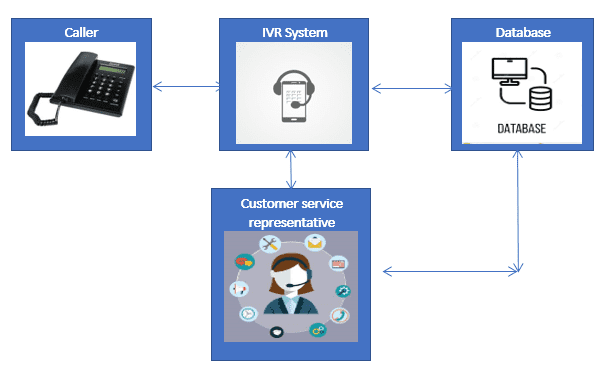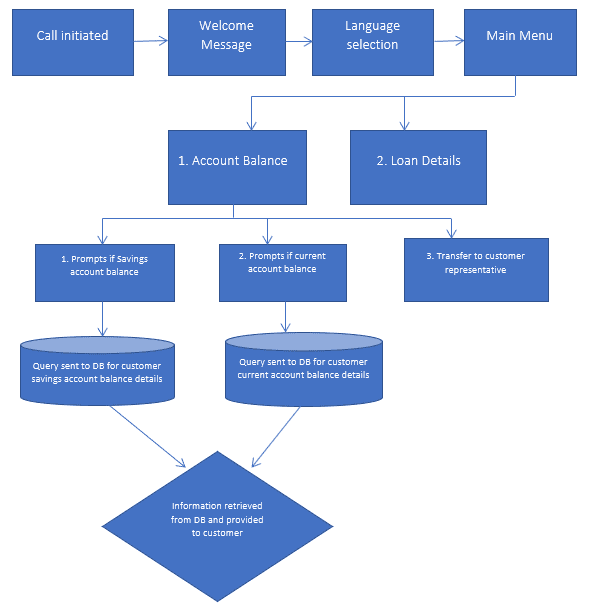- October 12, 2022
- Posted by: Krishanthi G R
- Category: Digital Assurance

Interactive Voice Response (IVR) is a developing technology that guarantees a better customer call experience, using a (Voice User Interface) that enables interaction between humans and computers. An automated telephone technology, IVR seeks to address the caller’s concerns via pre-recorded messages/prompts, consisting of various menus, sub-menus, and services. The end-user can select the required support from the multiple options available.
IVR is becoming increasingly popular across various industries, such as healthcare, banking, insurance, call centers, travel, etc. It can provide 24/7 support and minimizes the waiting time for customers. Earlier, the caller’s response used to be collected from the telephone keypad’s numeric inputs or via DTMF. However, IVR has become even more advanced and can respond to spoken end-user interaction.
Get in touch with us for digital assurance services
Get in touch
The IVR typically provides the following support with the gathered data:
- Resolve queries by giving necessary details
- Route calls to the appropriate representatives if suitable options are not found
- With the acquired information, raise an issue and arrange a call back without having the customer wait
COMPONENTS OF IVR SYSTEM


THE IVR CONTACT CENTER
The contact center is the point of contact where customer requests from different channels (IVR, Chat, chatbot, email, SMS) are managed. Almost all industries use contact center applications with 24/7 support to provide a better call experience and maximize revenues.
Each contact center and IVR application are developed uniquely per the organization’s requirements, procedures, number of calls, etc. These applications provide considerable value to the organization by offering a self-service feature to customers like surveys, order status, bill inquiries, bank balance, account status, etc.
For instance, when a customer calls a bank’s contact center,
- An automated system answers the call and asks the end-user to provide input by pressing “1” for choosing English, “2” for Tamil, “3” for Hindi, and so on. After the end-user’s input, the call proceeds with the selected language.
- It asks the caller to press “1” for account balance, “2” for reporting lost cards, or “3” for loan-related details.
- Based on the data the caller has entered, it queries the database, retrieves the required information, and provides it to the caller.
- Suppose the caller is unable to find a suitable option from the menu, there is an option to transfer the call to a customer service representative (live agent) who will assist with the query/issue.
SAMPLE CALL FLOW

The Importance of Contact Center IVR Testing
Digital assurance solutions check is performed to ensure that the developed software application functions as expected. The best and most commonly used IVR testing tool is Cyara, a licensed tool. Testing achieves the following objectives:
- Ensuring the developed software application functions as expected.
- Identifying and fixing faults to enhance service quality before the consumer discovers them and becomes dissatisfied with the service.
- Upgrading the IVR software application with new enhancements per customer requests/requirements.
- Ensuring customer satisfaction and monitoring the system’s performance with end-to-end testing.
- Performing load testing to identify if the application can handle a massive number of calls during peak times.
- Validating the contact center metrics and handling all metrics, including average call answer speed, call handling time, rate of call abandonment, and first-time resolution.
- Integrating the system with various components (PSTN, IVR System, Database, Customer Service Representatives (CSR), and testing the complete procedure for a better call experience.
- Validating the options/prompts related to the customer’s inquiry, so the customer does not end up disappointed.
- Checking if the voice quality and speed are consistent so the caller can communicate with the system.
Types of Testing Performed in the IVR System
Feature Testing
As the name implies, feature testing tests the application’s functionality and confirms it is working as expected. Every feature must be tested in the development stage to ensure it meets all the requirements. This testing verifies if the system responds to customer queries and behaves correctly without misdirecting, even if the customer gives an input that is unavailable in the menu.
Spike Testing
Spike testing is the same as stress testing as it verifies the application’s stability. Spike testing provides a solution to the IVR system that experiences pressure when there is a sudden increase in call volume. This testing method automatically generates many calls to identify the breaking point and fix the issues before it impacts the customer.
Load Testing
Load testing is performed to ensure the system can handle a heavy workload and identify the threshold and issues with higher volume. This method tests the system by generating an N number of calls and gradually increases the load (call volume) to monitor the system’s performance. This process helps us track the performance metrics, how the system behaves under various traffic conditions, and ensure that the system works as expected.
Stress Testing
Stress testing tests the system’s stability with abnormal or heavy loads at various levels. It is pretty similar to the load/spike test. In this test, too, the application is attacked with more than the max limit of calls/requests to identify the breaking point and evaluate how the system handles it. This testing also verifies security threats and error handling during system breaks.
Soak Testing
Soak testing is a process to measure the ability of the IVR system to handle a massive load for a more extended period. This testing involves continuously generating hundreds/thousands of calls per hour for 48 hours (or more) to monitor how the system responds in such conditions. Moreover, this process verifies if there are any memory leaks or loading issues and fixes them before it impacts the customer.
Regression Testing
Regression testing is performed to verify that the developed and tested software works as expected without any interruptions, even after introducing new changes in code.
Similarly, in IVR, regression testing is performed to ensure new updates and integrations do not break any crucial features (call flow, recording, etc.) of the IVR system.
Experience Testing
Experience testing tests the customer experience with the IVR system’s service. It is performed 24/7 by monitoring the systems’ calls, functionality, and performance and by making test calls. This process helps measure the system’s overall experience and improvises critical areas.
Essential Components Requiring Testing
Authentication Process
In today’s world, the chances of fraudulence are high, and it’s critical to test whether the IVR system is wholly secured. The application should always verify the customer with security questions (date of birth, address, etc.) for identification purposes.
Language Selection
Language selection is the first option prompted by the IVR system, and then the call proceeds to the selected language. Testing is performed to ensure that all the menus/submenus and responses are in the language chosen by the customer.
Dual-tone Multi-frequency (DTMF) Input
This feature provides inputs to the IVR system using 0 to 9 or other characters like * and # from the phone dial pad for all the menus and submenus. It is essential to test that the IVR acknowledges all the DTMF inputs properly and provides the correct information to the customer.
Repeat Option
Sometimes, the customer may not understand the option/prompt, which makes them unclear what inputs are required; the call may also get automatically disconnected. So there is an option to repeat the prompts to the customer before disconnecting the call. Hence, testing is performed to verify whether the repeat option plays when there is no input from the customer.
Call Routing
As the IVR system cannot solve all the queries, the call gets transferred/routed to a customer representative. There should be no call deviation at this point, and we need to validate whether the call is routed to the appropriate department.
IVR Workflow Testing
Once all the features are tested, it is vital to try the end-to-end flow of the system. We need to validate if all the prompts/menus are played per the customer’s queries and whether they are misdirected to the wrong departments.
Customer Feedback Study
This process is performed to identify if the customer is satisfied with the service and improve the experience per the customer’s needs.
At the end of the call, the customer provides feedback from the options played by the system using the numbers 1 to 5. Companies need to ensure the input is correctly registered in the database.
You might be interested in: Automated Visual Testing with Cypress
Conclusion
In today’s business world, the IVR system is a fundamental technology that supports customers 24/7 without relying on human resources.
IVR can constantly be updated and improved with new messages or options per customer requirements, making the call experience smoother. Also, with complete end-to-end testing of the software and the excellent quality of the IVR system, it brings a positive brand image and increases revenue to the organization.




